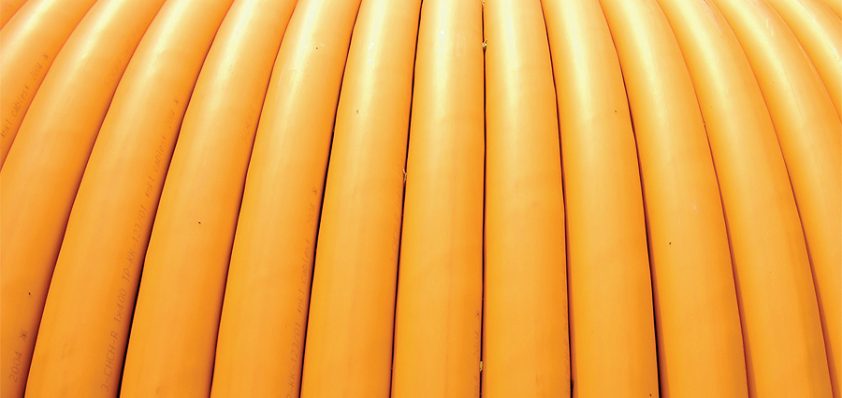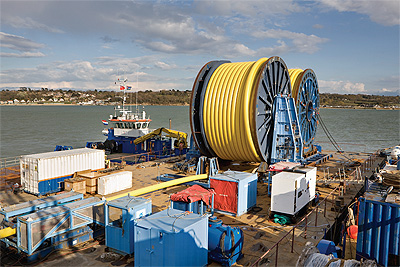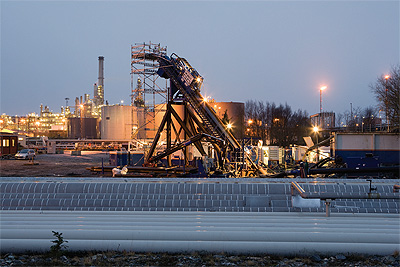
Visser and Smit Hanab is a leading name in the field of pipe and cable infrastructures and has origins dating back to the late 19th century
A leading example
The company has gone through a range of name changes and developments in its time and has incorporated a number of companies into its diverse structure since 1979. Its history and experience in oil and gas procedures means it is a forerunning authority in this highly competitive industry. The company employs over 1500 people and sees a turnover of 300 million euros. With its headquarters in the Netherlands, Visser and Smit Hanab has further offices in the United Kingdom, Belgium, Germany, Hungary and France, targeting markets in the Netherlands and Western Europe, and also in the Gulf region.

The organisation is not limited to involvement in the oil and gas industry but is also prevalent in the industries of sewage, water, electricity and refineries. The company prides itself on its wide-ranging capabilities and full package provision offering a complete service from conception and design to engineering and construction.
The organisation provides pipe and cable in both above ground and underground projects for the supply of energy, water, communication and associated facilities, ensuring that each project has the ideal method and solution to meet its specifications. Its comprehensive range of activities includes trenchless techniques, pipelines, maritime projects, mechanical engineering facilities, machine construction and boiler services. The development and technology division of the company ensures that Visser and Smit Hanab provides a consistent quality service at the forefront of the industry. As well as holding the position of a traditional contractor the company continues to be an adaptable construction business with emphasis on sustainable and innovative solutions, quality, flexibility and forward thinking attitudes to handle the demands of the fast changing oil and gas industry. With its unrestricted product range the company is able to hit industry changes head on as it has the capability to provide services regionally, nationally and internationally, both offshore and onshore. To this end the company has a customer focus, working closely with clients from a range of industries including utility companies, industrial organisations, telecommunication providers and public authorities, to develop a unique construction.
An example of this adaptable attitude can be seen in one of Visser and Smit Hanab’s most recent and unique projects carried out in Mongstad, Norway for StatoilHydro. The project involved detailed engineering and horizontal directional drilling, battling adverse weather conditions to connect the site of an oil refinery in Mongstad to an adjacent fjord. This assignment was particularly unique due to the exceptional way in which the drilling was conducted. The angle at the point of entry had to be 45 degrees, due to the fact that the exit point was at a depth of 234 metres below sea level. However, continuing the wide angle to the bottom of the fjord would have made it impossible to pull the 12-inch gas pipe from the floor of the fjord into the drilled hole. Meaning that accurate drilling of a curved line was necessary into the drilled hole.
Subsequently the details of the horizontal directional drilling involved strategic planning as the rig is not designed to function at such an angle. Adjustments to the rig had to be explored, as well as taking into consideration the Norwegian soil conditions, as the ground around Mongstad is made of solid rock. In order to deal with this delicate operation Visser and Smit Hanab worked closely with the client before and during the drilling process, where it was decided that the drill-head would be pulled out after every 100 metres in order to inspect the bored section with a gyro to compare results with the position tracking system.
The point of exit was reached within 37 days, and the angle and location of this had to be checked with the client to ensure it was exactly as they envisioned. A remote offshore vessel (ROV) was used to measure the exit point and was approved by StatoilHydro, while video inspection was also used to detect and assess any cracks in the rock. However the diameter of the pilot hole (350 mm) was not big enough to pull the product pipe from the floor of the fjord to the surface – it had to be enlarged to approximately 500 mm. The final stage of the project could only be carried out once a hole opener was used to ream the bore hole and more video inspection work was carried out. Further expertise was needed to insert a 24 mm nylon pull cord connected to a type of runner; using high water pressure the runner was thrust to the bottom of the fjord and the cord was used to insert a steel pull cord into the drill hole, which in turn was used to pull the 12-inch gas pipe into land, in order to complete this complex project.
The company has also recently completed a project in the UK, replacing the existing water pipeline of Southern Water running from the UK mainland to the Isle of Wight. This line crosses the Solent, involving the construction of two new pipes with a diameter of 400 mm and the refurbishment of an on-land booster station. The project started in Autumn 2006 with the drilling of two boreholes at either side. The project team decided to drill only a pilot hole with a 24-inch drill bit, and during the drilling the four PE pipes (2x 1200m and 2x 750m) from Pipelife Norge SA were towed onto site. After punch out on the Solent seabed, the PE pipes were successfully drawn through with the use of the HDD-assisting pontoon ‘Fetsy-L’. The second phase of the project took place earlier this year, connecting the four pipes. Visser & Smit Hanab collected the pipes by using two enormous reels on a transport barge belonging to its sister company, Stemat. During all the marine activities Visser & Smit Hanab was engaged with the refurbishment of the booster station. The existing pumps had to be replaced by three new high performance pumps, and when all the joints were tested, secured and disinfected the company was able to hand over the pipelines to Southern Water.
boreholes at either side. The project team decided to drill only a pilot hole with a 24-inch drill bit, and during the drilling the four PE pipes (2x 1200m and 2x 750m) from Pipelife Norge SA were towed onto site. After punch out on the Solent seabed, the PE pipes were successfully drawn through with the use of the HDD-assisting pontoon ‘Fetsy-L’. The second phase of the project took place earlier this year, connecting the four pipes. Visser & Smit Hanab collected the pipes by using two enormous reels on a transport barge belonging to its sister company, Stemat. During all the marine activities Visser & Smit Hanab was engaged with the refurbishment of the booster station. The existing pumps had to be replaced by three new high performance pumps, and when all the joints were tested, secured and disinfected the company was able to hand over the pipelines to Southern Water.
Like many in the oil and gas industry the company is experiencing the ill-effects of the global lack of skilled workers in the trade, however the company is set to address these issues over the next five years and feels that its emphasis on quality will maintain its leading position. Visser and Smit Hanab attaches the greatest importance to meeting the expectations of its clients with its products and services. In order to achieve this aim the company recognises the importance of appropriately organising, constantly monitoring and consistently improving its systems and procedures. To this end the company’s quality management system is comprehensive and a powerful tool in the realisation of these objectives, and has been NEN-EN-ISO 9001 certified since 1993.
Visser and Smit Hanab’s quality plans are a mainstay of its quality management system, overseeing the specific quality control of a project, ensuring the requirements and conditions set out by the client are met precisely. The client may even be involved in the layout of the quality plan, allowing the activities and requests of both parties to be harmonised at an early stage. In conjunction with this, the quality control management system ensures that the health and safety of employees is also of paramount importance.
The oil and gas industry is key in the fight for sustainability and environment issues; it is essential that businesses in this powerful industry are committed to the cause. Visser and Smit Hanab is a leading example in the field for tackling these global issues and the management puts emphasis on corporate and social responsibility as a matter of course. The company has ambitions to go over and above the statutory regulations and requirements for sustainability in the industry and its environmental policy statement creates a framework for its transparent and thorough environmental programme to be implemented through its staff and external parties. Its key goals in preparing and executing activities are to prevent air, water and soil pollution, reduce noise pollution and other disturbances during construction processes, as well as considering the supply and location of its raw materials and energy. The environmental management system is drawn up on the basis of the international standard NEN-EN-ISO-14001:2004 and the company is constantly striving to develop and innovate its environmental procedures.
Visser and Smit Hanab serves a diverse range of clients in a number of industries, with the highest quality pipe and cable for all energy, water and communication needs. With its dedication to innovation, customer satisfaction and environmental sustainability, the business looks set to be a leading example in the industry for another hundred years.
Visser and Smit Hanab
Services Pipe and cable